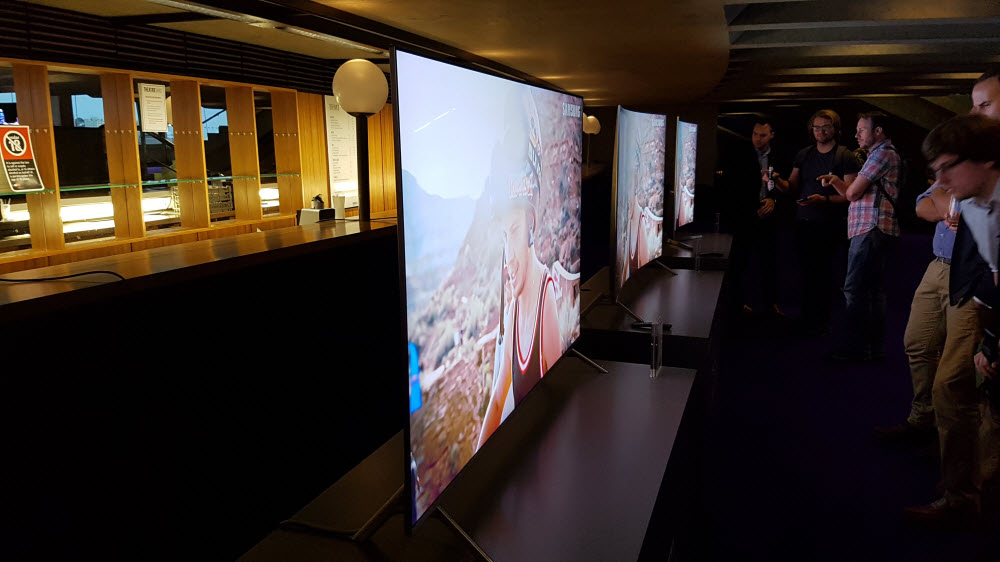
Samsung yesterday held the Australian launch of its premier 2017 QLED TVs in . The range hits Australian retailers in April and comes in three series (Q7, Q8 and Q9), with three screen sizes in each series with prices starting from $4,499 and ranging up to $39,999.
In interesting change to TV launches of the last few years, the entire event was actually quite light on buzzwords and gimmicks – indeed, Samsung’s own press release for the event doesn’t even mention the most common TV buzzword of the last two years (high dynamic range). The company instead is preferring to focus on picture quality, design and Smart TV features to drive interest from Australian consumers.
Of the sets, the Q9 is the the obvious favoured child with a gorgeous, minimal design. It doesn’t equal the extreme thinness of some recent competitors’ offerings, but it doesn’t need to. The Q7 is a step down from the Q9 (and isn’t available in quite so large panels), and the Q8 offers customers a curved panel option should they want it.

You might guess that the Q in QLED stands for “Quantum dot” technology, and you’d be right – Samsung tells us that they’ve reengineered their quantum dot technology using a new alloy material to allow the TV to show amazing colour depth regardless of the panel’s brightness. The results are pretty stunning, with the Q9 able to push a new high of 2,000 nits brightness (the Q8 and Q7 can push 1,500) without compromising colour or details in the picture – the measurement for this accuracy across different levels of brightness is called “colour volume”, and Samsung’s proud that these sets have been certified by Germany’s VDE as being able to produce 100% colour volume.
There’s a new approach to wall-mounting too, with a lot of the apparatus needed to mount the TV on the wall now within the TV body itself (save for a small bracket), leaving no gap between the TV and the wall and the TV capable of a larger amount of movement while mounted on the wall. Another clever wall-mounting solution sees a support mount for sound bars attached to the TV itself rather than needing to mount it separately on the wall.
You won’t need to move the TV around to find input ports though, as Samsung’s simplied the cable requirements for the TV down to a power cable and an optical fiber cable that connects the TV to a break-out box where you’ll find the usual array of input ports. The TV and stand designs also conceal the cables within, and the cables themselves are so slight you might be able to use a few tricks to conceal them on your wall.
Pleasingly, Samsung’s Smart TV “Smart Hub” interface has evolved into a simpler, more minimal interface than days of old. It puts apps and inputs in a scrolling panel at the bottom of the screen. The TV now also detects external devices connected to HDMI ports and offers them as named items in the user interface – so now you can press “Blu ray player” or “Chromecast” instead of having to remember that you plugged your Blu ray player into HDMI2 and Chromecast into HDMI4. We also spotted an app for Google Play Movies & TV in the menus, so you’re able to bring some of Google’s ecosystem onto your Samsung TV.
Samsung’s also placing a big emphasis on its stylish One Remote, offering a simple control experience. The TVs can also control connected devices by passing signals back over their HDMI cables using the CEC (Consumer Electronics Control) protocol – you don’t need to have all your devices in IR line of sight any more. You can also put the One Remote down and use an app on your Android or iOS device to control the TV, and you’ll get an in-app reproduction of the on-screen options for apps and input selections.

The super premium new TVs are all well and good, but they do of course carry premium price tags to match. As we saw with last year’s TV lineup, the real interesting stuff happens in the main consumer range. Much of the premium new technology and features will eventually make their way down to Samsung’s UHD range, and last night we also saw a preview of the new TVs in this range for 2017 with both flat and curved panels on offer, and advanced cable management coming down from the Q series. While these TVs weren’t the focus of the event, Samsung’s clearly excited at the upgrades it’s going to be able to bring to this section of the market too.
Are you in the market for a new TV? How does Samsung’s QLED range sit with you? Tell us in the comments!






Wait 6 months and they will halve in price. Do not trust Samsung, they do not release firmware updates that they promise however the screen is brilliant.
“Samsung’s simplied the cable requirements for the TV down to a power cable and an optical fiber cable that connects the TV to a break-out box where you’ll find the usual array of input ports.”
This is a fantastic idea. So much better that having to run multiple cables to the TV or, doing this yourself with an HDMI switch.
They had already done this with the 2016 series TV’s using the One Connect cable. The advance this year is that it is now an optical fibre cable instead of the black one last year. May be looking for two 9 series 65’s very shortly!